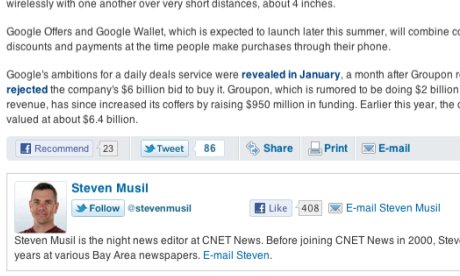Facebook's tentacular reach across the internet was accelerated by its 'like' button, which now seems a ubiquitous part of the browsing experience from news and blogs to corporate and retail sites. By late April, the like button had been added to 250,000 sites outside Facebook, feeding information back to the site on the activity and preferences of its 650+ million users. Though third-party buttons have been around for years (Digg this! Wordpress that!), the scale and recognition of Facebook's like button hasn't escaped the notice of Twitter and Google, and both are introducing rival (or perhaps complementary) buttons this week.
 Twitter's new follow button on the CNET site
Twitter's new follow button on the CNET siteTwitter announced its 'follow' button last night with 50 sites already plugged in, including Huffington Post and the Wall Street Journal. The follow button sits next to a named Twitter user, and lets the reader start following that account on Twitter with one click. The Twitter account name and number of followers appear next to the button. Third party sites add the button by adding a short piece of code.
The latest eMarketer estimates put Twitter's US audience at 20.6 million adults for the whole of 2011, up from 16.4 million in 2010, compared to Facebook's 132.5 million for this year. Twitter expects the follow button to drive more activity on the site, perhaps helping to bring some of those stagnant accounts back to life; a study by web analysts RJ Metrics earlier this year estimated that only 17% of accounts had actually tweeted during the previous month.
"For publishers and brands, adding the Follow Button to your website and using Twitter to stay connected with your audience is a powerful combination," said Twitter in the announcement. "People who follow your account are much more likely to retweet and engage with your Tweets, and to repeatedly visit your website."
Google's unveiling of its new +1 button had to be moved forward after a partner company accidentally leaked the news. +1 first launched in late March next to search results for just 2% of English-language results in the US. This next phase of +1 will put it in much more direct competition with Facebook's like, inviting third-party publishers to add the button to their sites.
It's a good thing if this new generation of third-party buttons offers consumers more choice. But it won't be good for web users if it adds a confusing, cluttered extra panel of options. It will be left to the discretion of site owners to decide which is most relevant for their particular site, but in terms of usability and reach, Facebook would very much seem to have the first mover advantage. 'Like' as a concept, is more immediate, more understandable and doesn't need interpreting, whereas +1 invites an explanation. Twitter's 'follow' is somewhere in between, an advert to lure in new users but with that Twitter terminology that will still be a mystery to much of the web population.
Comments